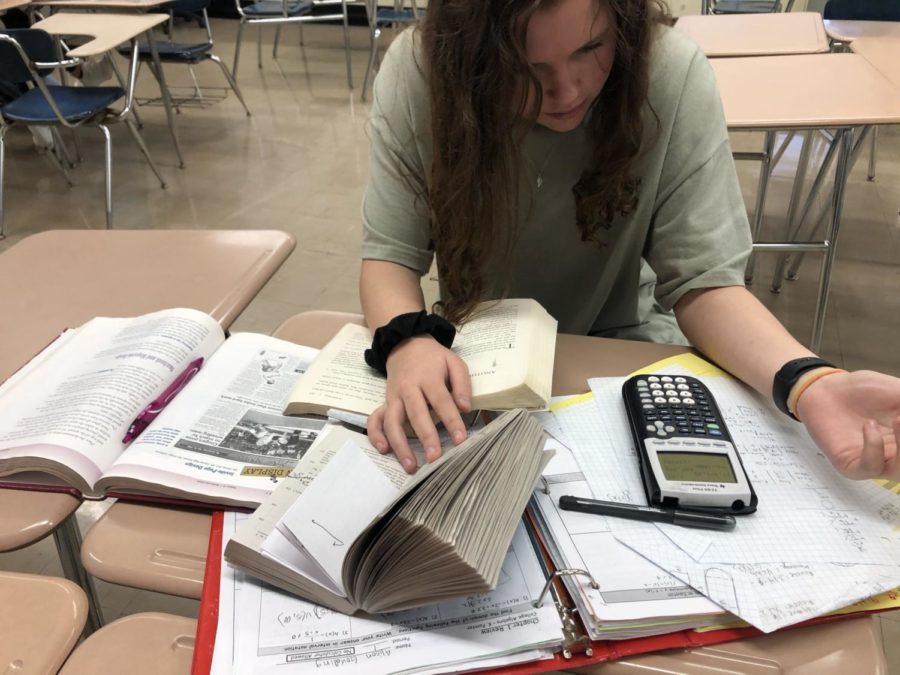The school provides solutions to students’ anxious feelings
November 22, 2019
School can often create stress and anxiety for students. The school works to help students who do feel stressed or anxious.
Feeling anxious every now and then is a human reality; however, there is a growing number of adolescents diagnosed with generalized anxiety disorder in recent years. Having anxious feelings is different from generalized anxiety disorder, yet both are becoming more common. 25.1% of children between the ages of 13 to 18 years old are effected by anxiety disorders.
Often teens blame the stress and pressure school creates as a main factor in the increase of anxiety. Associate Principal for Counseling and Support Services Vincent Walsh-Rock speculated the cause of increased teenagers diagnosed with anxiety.
“I think that schools tend to function the same way they have always functioned, so the experience really hasn’t changed much; however, the way students interact with it has changed. That’s where students have felt more anxious sometimes around school, and the school experience because of all the things that are going on outside of school,” Walsh-Rock said.
Senior Jack Kwiatkowski has generalized anxiety. He described the stress and pressure that homework can cause him.
“It’s not like having the thought of having hours of homework is what causes anxiety or causes like anything for me. [My anxiety starts] once I start doing it [homework]. I start going through things fluently, and [then] I hit a roadblock,” Kwiatkowski said.
In replace of changing the ways school functions to reduce the stress and anxiety it can cause, DGS has shifted their focus on ways to help students who are feeling anxious or stressed. One improvement is the creation of a calming room in the counselor’s office. The calming room is a place where students can go when they are feeling emotionally unready to learn.
The calming room was started last school year, and was continued into this school year. Walsh-Rock described the room and it’s purposes, as well as how it has been working.
“We actually have one of our offices in the counseling office, there’s no counselor in it. We use it as a calming room… We’ll have a student or two come down because they don’t even want to talk about what is stressing them out. They just need to regulate and breath. Sometimes someone will work with them to lessen their anxious feelings so that they [the student] can get back to class. It’s worked out really well,” Walsh-Rock said.
Another strategy the school has employed is a website accessible to all students that was created by the counseling department for the purpose of teaching students strategies on how to deal with stress. Counselor Jenny Franz was part of the team to create the website. She spoke about why it is important to have these resources out there for students.
“Everybody experiences stress and we don’t always know how to handle it. You don’t always have time to come to your counselors and talk about why things are stressful. I look at it like the more tools we can give people, the more information we can share with people about how to handle stress and how to actually understand what it does to your body” Franz said.
Franz has taken courses to become a certified mindfulness instructor, and taught mindfulness last year to first-semester health classes and two math classes. She spoke about why she believes it is important to share the message of mindfulness and stress relieving strategies.
“I thought if I can just get the message out to students in classrooms or individually that they might be able to actually feel empowered and help with their own learning and their own relaxation,” Franz said.
Sophomore Jozette Nunez has learned about the strategies the school has employed to help students who are feeling stressed. She spoke about why these strategies may not always work.
“It’s hard to make time to relax because you have to do everything,” Nunez said.
For students with more severe diagnosed anxiety, the school has three separate programs that work to ease their anxiety. Social worker Stephen Buhr works closely with the programs and described their layout.
“The least restrictive student can have up to four class periods where they have a smaller environment. These students would have a special ed teacher and then more flexibility in what we can do to support them. The rest of the day they’re out in regular classes… Then if that’s not what they need and they need a little bit more, we can ramp it up to either that ED [emotional disability] supportive or what we call [an] ED directive,” Buhr said.
The curriculum for the class is the same as regular classes; however, some of the homework may be modified or more time may be given to reduce the stress and anxiety surrounding it.
The school continues to work to help students with resources to help with the stress and anxiety can cause.
“I think the focus has been more on the students who do feel anxious, making sure we work with [our] teachers, and especially [creating] some resources to help students,” Walsh-Rock said.
